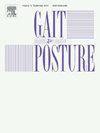反应性任务对老年轻度认知障碍患者步态启动的影响
IF 2.2
3区 医学
Q3 NEUROSCIENCES
引用次数: 0
摘要
背景:患有轻度认知障碍(MCI)的老年人表现为运动控制缺陷和认知能力下降。步态启动是一项复杂的运动任务,涉及动态姿势调整、跌倒风险和认知需求。反应时间任务增加了注意力和认知要求。本研究考察了轻度认知障碍患者和认知健康成人的步态启动是否不同,以及反应时间任务是否会影响表现。方法共招募30名参与者,包括11名轻度认知障碍患者和19名认知健康对照。在两种情况下评估步态启动:自我启动和光触发反应性步态启动。采用高速运动捕捉相机和测力板采集生物力学参数,测量压力中心(COP)和质心(COM)运动时间、位移和速度,以及步长、步宽、落地角度等步态参数。采用双向混合方差分析研究认知功能和任务条件对步态启动性能的影响。结果成年MCI患者在反应时间任务下,动作时间短,COP位移短,COP速度快。在反应时间任务条件下,两组均表现出较短的总步态起始时间、较大的COP位移、较快的COP速度、较短的COM位移、较慢的COM速度和较短的步长。结论老年轻度认知损伤患者的步态评估应包括步态起始分析,最好结合反应时间任务。在解释结果时应特别注意COP参数。本文章由计算机程序翻译,如有差异,请以英文原文为准。
Effects of a reactive task on gait initiation in elderly individuals with mild cognitive impairment
Background
Older adults with mild cognitive impairment (MCI) exhibit deficits in motor control alongside cognitive decline. Gait initiation, a complex motor task, involves dynamic postural adjustments, fall risk, and cognitive demands. Reaction time tasks increase attentional and cognitive requirements. This study examined whether gait initiation differs between individuals with MCI and cognitively healthy adults and whether a reaction time task influences performance.
Methods
A total of 30 participants were recruited, including 11 individuals with MCI and 19 cognitively healthy controls. Gait initiation was assessed under two conditions: self-initiated and light-triggered reactive gait initiation. Biomechanical parameters were collected using high-speed motion capture cameras and force plates, measuring center of pressure (COP) and center of mass (COM) movement time, displacement, and velocity, as well as gait parameters such as step length, step width, and landing angle. A two-way mixed ANOVA was conducted to examine the effects of cognitive function and task condition on gait initiation performance.
Results
Older adults with MCI exhibited shorter movement time, shorter COP displacement, and faster COP velocity when performing gait initiation under the reaction time task. Under the reactive time task condition, both groups demonstrated shorter total gait initiation time, greater COP displacement, faster COP velocity, shorter COM displacement, slower COM velocity, and shorter step length.
Conclusions
Gait assessment in older adults with MCI should include gait initiation analysis, preferably incorporating reactive time tasks. Particular attention should be given to COP parameters in result interpretation.
求助全文
通过发布文献求助,成功后即可免费获取论文全文。
去求助
来源期刊

Gait & posture
医学-神经科学
CiteScore
4.70
自引率
12.50%
发文量
616
审稿时长
6 months
期刊介绍:
Gait & Posture is a vehicle for the publication of up-to-date basic and clinical research on all aspects of locomotion and balance.
The topics covered include: Techniques for the measurement of gait and posture, and the standardization of results presentation; Studies of normal and pathological gait; Treatment of gait and postural abnormalities; Biomechanical and theoretical approaches to gait and posture; Mathematical models of joint and muscle mechanics; Neurological and musculoskeletal function in gait and posture; The evolution of upright posture and bipedal locomotion; Adaptations of carrying loads, walking on uneven surfaces, climbing stairs etc; spinal biomechanics only if they are directly related to gait and/or posture and are of general interest to our readers; The effect of aging and development on gait and posture; Psychological and cultural aspects of gait; Patient education.
 求助内容:
求助内容: 应助结果提醒方式:
应助结果提醒方式:


